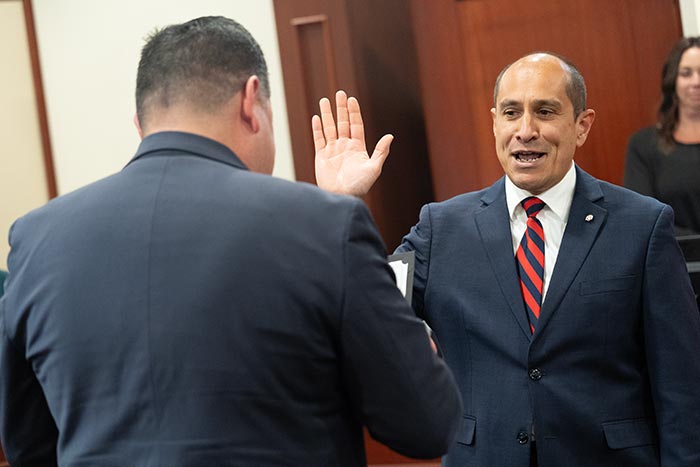Safe housing program combats crime
No matter where you live, your home is your castle. When you look at recent crime statistics, however, it becomes obvious why castles have moats and drawbridges and hot tar.
In Claremont, the C
At the urging of the committee and city staff, in April 2009 the Claremont City Council joined the Crime Free Multi-Housing Program, which works with landlords, property owners and managers to keep illegal activity out of rental property. Successfully utilized in over 2,000 cities nationwide, the program was modified and adapted to fit the needs of the Claremont community.
“We had an extreme situation at the Claremont Cottages,” says Jim Keith, chairman of the Committee for Safe and Healthy Housing. “The complex was deteriorating. There were trashed units, graffiti and intimidating residents scaring people out of there. It was a bad situation and drew attention to the need for this program.”
The Committee for Safe and Healthy Housing has spent a great deal of time working on implementing the program. Volunteers have attended training, held regular meetings, met with property owners, managers and residents and developed a training manual to promote safe and healthy living environments at apartment communities.
To date, five of the 29 complexes within the city have been certified in the Crime Free Multi-Housing Program: Claremont Villas (100 S. Indian Hill Blvd.), Courier Place (111 S. College Ave.), Plum Tree (284 N. Carnegie Ave.), Access Village (1730 N. Towne Ave.), and Claremont Village Green (630 W. Bonita Ave,).
“We had over 100 residents attend our last meeting,” says Elena Griza, manager at the Claremont Village Green. “They were responsive and open to suggestions on how to make the complex and their units a safer place. The organizers were surprised how involved and how seriously the residents took it. It’s working out very well.”
As part of its partnership with the committee, the Claremont Police Department tracks apartment calls for service, providing reports to the apartment managers, Police Commission and city council every six months. Lieutenant Aaron Fate has been designated the police liaison to the program, providing crime data and analysis, attending semi-annual meetings with apartment owners, managers and residents, and participating in annual trainings.
“Lieutenant Fate has been involved from day one,” says Crime Free Multi-Housing Coordinator Bob Kern. “He’s very hands-on,. We’re lucky to have him.”
With the help of program members and Claremont police, many apartment complexes throughout the city have experienced a decrease in crime. Both Plum Tree and Claremont Village Green have seen a 50 percent reduction in Part 1 crimes since the program’s inception in 2009. Part I crimes are comprised of crimes against persons (murder, rape, robbery and aggravated assault) and crimes against property (burglary, theft, auto theft and arson).
Two broken security gates at an alleyway located on the 500 block of San Jose Avenue had been an ongoing problem. As a result, the alley had turned into a dumping ground for discarded water heaters, mattresses and stripped cars as well as providing criminals with easy access to residents’ vehicles. After years of trying to address the problem with the San Jose Apartment Owners Association, it was an officer-involved shooting in May 2014 that brought the passageway problem to the forefront.
“The gates are now fixed,” says Mr. Keith. “That’s big! Over 80 percent of Part I crimes have involved autos in those alleys. Hopefully, now that it’s no longer open, residents are going to have a higher quality of life and peace of mind in that area.”
Becoming a part of the Crime Free Multi-Housing Program is a fairly simple process. Mr. Kern and a member of the Committee for Safe and Healthy Housing walk the rental property, taking notes on recommendations to improve the grounds and the units.
“We write up a report on things we want done and give it to the manager,” explains Mr. Kern. “Once they go through the training sessions and I inspect their property with a list of items I’m looking for, they get a certificate and a sign that they can post stating they are crime free.”
Scheduled in the fall, the training sessions consist of two, four-hour meetings held at the Hughes Center covering various topics including tenant hoarding, illegal smoking and loitering of non-residents as intimidation. In years past, expert speakers have included representatives from the Claremont Police Department, Code Enforcement, Los Angeles County Fire Department, Housing Authority and the Apartment Association for the Greater Inland Empire and Fair Housing.
“We also have a lawyer come in to talk about how managers and owners can cover themselves with new laws,“ says Mr. Kern. “We’re serious about what we’re doing here and we’re trying to make things better.”
In addition to the five certified crime free complexes, four more complexes have expressed interest in participating in the Crime Free Multi-Housing Program. With 20 complexes still left in limbo, Ms. Giza doesn’t quite understand the hesitation of managers and owners who have yet to get with the program.
“They are making a huge mistake,” she says. “At least give it a try. You’ll be surprised how efficient it is and how involved the residents become. Imagine you’re in a small town with 300-400 people and we get together to talk and come up with ideas of what we can do better. As a manager, you have to keep up with the laws and ordinances or it could become a liability.”
The Crime Free Multi-Housing program is free and open to anyone. For information or to volunteer, contact Bob Kern at (909) 399-5498 or by email to bkern@ci.claremont.ca.us.
—Angela Bailey
news@claremont-courier.com










0 Comments